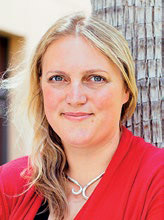
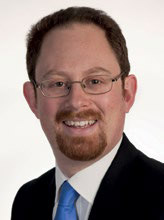 Alison Goldsworthy is founder and CEO of the Depolarization Project. Previously Deputy Chair of the Liberal Democrats, since 2016 she has served as senior advisor to Stanford University’s Conflict and Polarization Initiative. You may follow her on Twitter @aligoldsworthy. Julian L. Huppert, a former Member of Parliament for Cambridge, UK, is Director of the Intellectual Forum, Jesus College, Cambridge. You may follow him on Twitter @julianhuppert.
Alison Goldsworthy is founder and CEO of the Depolarization Project. Previously Deputy Chair of the Liberal Democrats, since 2016 she has served as senior advisor to Stanford University’s Conflict and Polarization Initiative. You may follow her on Twitter @aligoldsworthy. Julian L. Huppert, a former Member of Parliament for Cambridge, UK, is Director of the Intellectual Forum, Jesus College, Cambridge. You may follow him on Twitter @julianhuppert.
There has been much discussion of increasing political polarization around the globe, particularly in Western liberal democracies. Chants suggesting we lock up our leaders have reverberated around stadia. Politicians from mainstream parties and their young children have had to be escorted home by a phalanx of policemen while abuse is hurled at them. It is becoming standard for parliamentarians to need panic buttons fitted into their bedrooms. While polarization broke into the consciousness of the United States and the United Kingdom in the aftermath of the 2016 Brexit and presidential votes, it has long historic tendrils.
In the last twenty years, the American National Election Survey has registered a near doubling in hostile feelings between Democrats and Republicans. As people see others more negatively, they ally with their own, increasing party loyalty. It’s a vicious cycle that is tremendously difficult to unwind. Respondents to the World Economic Forum’s 2019 Global Risk Report ranked “increasing polarization of societies” second only to climate change as an underlying driver of risk.
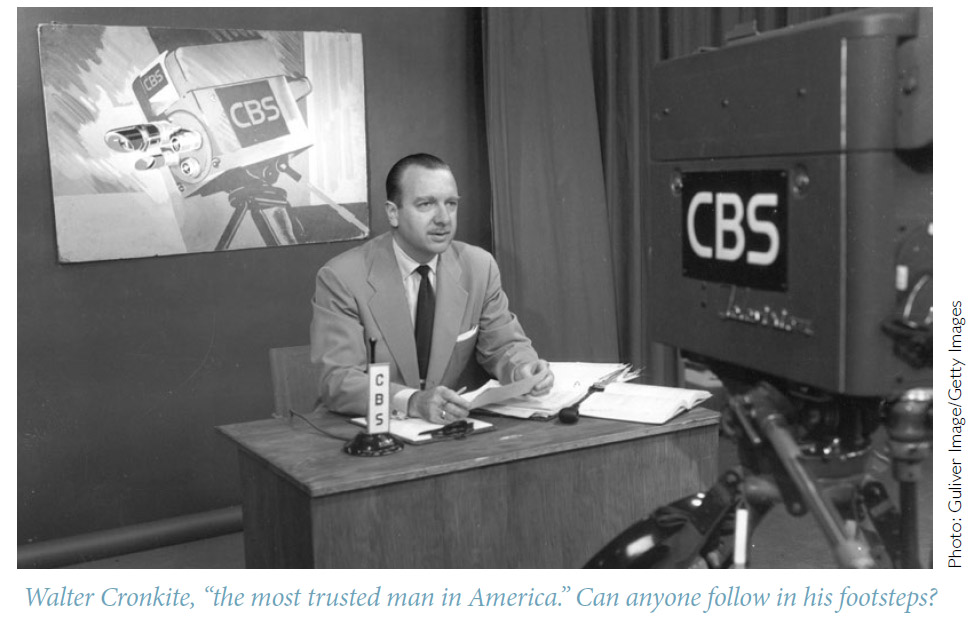
Polarization is not always along the lines of issues, though it can be. Instead we are undergoing “affective polarization,” whereby our political identities become the common dividing line: Leave or Remain; Trump or Never Trump; Democrat or Republican. This means people can have little idea what others actually think about an issue, resulting in perceptions of other’s views that are wildly inaccurate. More in Common’s research found that in the United States 85 percent of Republicans think controlled immigration can be good for that country. Yet, Democrats estimate just 52 percent of Republicans believe that. Similarly, 29 percent of Democrats believe America should have open borders. Republicans estimate 62 percent of Democrats want completely open borders.
This is not the first time the world’s most advanced nations have polarized. Those periods have typically ended in civil unrest, deep recession, or war. Jolts to the system that force people to challenge assumptions and beliefs that have become deeply held.
Attempts to alleviate our poor perceptions, divisions, and buck the historical trend also face significant barriers. We increasingly work, live, and interact with people who are politically similar to us, so there is little chance to course correct. Instead, the gap widens and, as we argue in this essay, it makes the future look bleak. There are no easy solutions and we believe we may have now passed the point where the UK, or United States, can rescue itself without experiencing very serious consequences. Things are going to get worse before they get better.
Bayes and Jaynes
We root our concern not just in contemporary observation, but also by drawing from fundamental mathematical modeling. In the eighteenth century, the Reverend Thomas Bayes became interested in statistics and probability. Although he died before publishing his work, over the following centuries his approach, and in particular the eponymous Bayes’ theorem, has revolutionized the way people think about probability and likelihood, compared to traditional frequentist techniques—the version of statistics still taught in schools.
At heart, his work considers the idea of prior belief, which is then modified by new information to produce an updated belief. Rather than assuming a neutral “null hypothesis,” Bayesian thinking emphatically relies on subjective belief and understanding as a tool to interpret new information—whether we believe something depends on how plausible we think it to be.
This all sounds extremely theoretical, but turns out to be powerful and useful in everyday situations: Bayesian inference is used for everything from AI pattern recognition and email spam detection to medical decision-making. Social psychologists have used it as a core way to explain our failure to update our beliefs in other contexts too.
One of the pioneering works on applying Bayesian thinking to everyday situations was written by E.T. Jaynes. Like Bayes himself, Jaynes died before his work could be published. In his groundbreaking book, Probability Theory: The Logic of Science (2003), he considers many creative examples, including a novel and ahead of its time mathematical analysis of the polarization of opinions.
Section 5 of that book, wonderfully entitled “Queer Uses for Probability Theory,” investigates ideas of “converging and diverging views.” In great mathematical detail, Jaynes considers how people respond to new information, when they started off with different views. Fortunately, it is possible to outline the key point of the argument in more accessible language, while relying on his work for the formal proofs.
Let us start by imagining two people, A and B. One of them believes something is probably untrue, the other believes it is most likely to be false. Now imagine that there are two “experts”—Dr. X who insists on the truth of the argument, and Professor Y who is adamant it is false.
If A and B were both to listen to the opinions of both Dr. X and Professor Y, what would happen? Naively and hopefully, we might want them to reach some sort of sensible middle ground, to reflect thoughtfully in their points and consider their own position. In reality, however, A is more likely to believe Dr. X, whose opinions are closer to A’s own, and to disbelieve whatever Professor Y says. Conversely, B will trust Professor Y’s words more than Dr. X’s. As a result, A is likely to believe more strongly than A used to in the truth of the claim, and B will be even more certain of its falsity. Providing extra information to both A and B has increased their polarization—even though in this model both cases were heard. (See Figure 1)
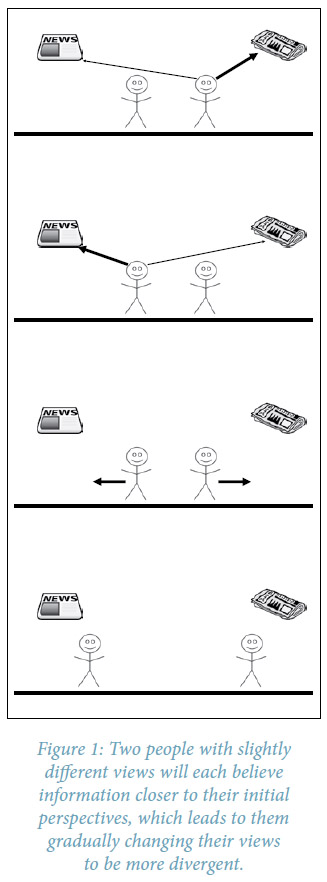
How does this apply for a larger population? Jaynes presciently identified that people who start on one side of the midpoint—no matter how slightly—will believe the information source closer to their initial position. The weight they give to that relatively agreeable update outweighs the pull of one that confounds it. Consider it this way: does the reader think the typical person is more likely to listen to someone who tells them they are broadly right or totally wrong? Once we get into the space of more authoritarian leaders this effect becomes yet more exaggerated. Erdogan and Orban are not known for filling their courts with critical voices.
This effect will be larger for those who are already further away from the balanced mid-point. Again, this does not rely on the premise that people are not presented with views that oppose their own, simply that they will tend not to update their position as a result of exposure to opposing views.
This process can then repeat, widening the gap and ultimately splitting up what was a broadly coherent group of people into two groups whose new beliefs are clustered around the two opposing news sources they now find themselves rallying around. A physical picture of this might be the effect of bringing two powerful magnets towards a pile of iron filings—the iron filings will be pulled one way or the other, sticking to the magnet that was nearer. (See Figure 2)
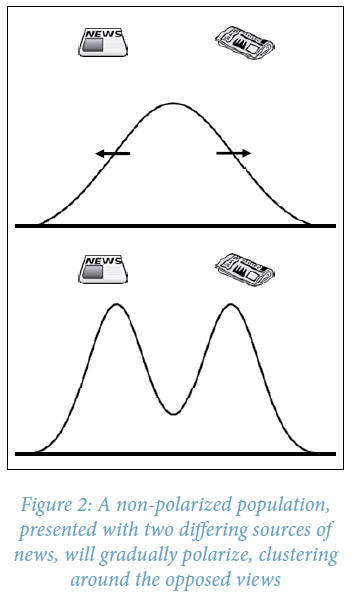
Wrong Yet Supported
Does this Bayesian model accord with reality? Fortunately, behavioral science scholars have conducted large-scale experiments to show that this theory holds true. In findings published in 2016, Harvard’s Cass Sunstein together with three colleagues from University College London tested the response of those who doubt man-made climate change is real and those who strongly believe in it to new information. This new information either confirmed or challenged their existing beliefs. The findings supported Jaynes proposition.
In other words, exposure to scientific evidence that agreed with an individual’s viewpoint caused people to hold onto that view more strongly, whereas exposure to a view they disagreed with had little difference on their belief. We update our information and beliefs asymmetrically, depending on whether we agree with them.
This experiment has been given added nuance in recent years. Ohio State University’s Thomas Wood and George Washington University’s Ethan Porter undertook similar tests and concluded that while people could accept their facts may be wrong, it rarely led to a change in beliefs. This explains, for instance, why Trump supporters may not believe he was wrong about the path of Hurricane Dorian but continue to support him anyway. Uncomfortably, human beings are not very good at accepting they were wrong and changing their outlook. We invite the reader to try applying this to his or her own experience.
Small differences in initial belief are magnified by interactions with new information sources and result in people who started off with similar views being dragged apart by other identities. Over time, these groups develop perception gaps of what “the other” thinks, making relations harder, and driving yet more polarization. Who delivered a given message becomes increasingly important, not what is said.
Behavioral scientist Joseph Marks, whose recent book, co-authored with his colleague Stephen Martin, Messengers: Who We Listen To, Who We Don’t, and Why (2019) is littered with examples of this: this and other research shows the considerable spillover effects of learning someone’s political persuasion. On even the simplest tasks, such as categorizing shapes, people conclude, falsely, that those of a politically similar mind to their own could do it better.
There is a darker consequence to this polarization, too. Authoritarian strongmen (and it is almost always men) become more likely as the public increasingly sees value in similar hardline opinions, over and against compromise. This bodes ill for democracy.
This analysis so far cannot be complete, or we would never have returned to a more peaceful norm after periods like Britain’s three-day workweek and widespread strikes in the 1970s and 1980s. How can this model explain a return to periods of lower polarization? Does it allow for countervailing forces?
A key part of the answer is that people do not just see information from strongly polarized news sources, as Queensland University of Technology’s Axel Bruns and others point out in their excellent critiques of over-reliance on online filter bubbles as an explanation for polarization. They also have discussions with other people—friends, family, co-workers, and anyone in their social circles, online or off. As long as many of those an individual interacts with are broadly centrist—or at least more centrist than they are—this will mean their views will also be shifted in a more centrist direction.
Alternatively, not all conversations are created equal—messages from a close family member can be more meaningful than an encounter with a neighbor. But in these situations, equilibrium can develop, where polarized sources drag people’s views away from the center, but their interactions with others drag them more centrally. Given the appropriate balance of these two effects, there can be a very stable, largely non-polarized society, as we have often seen in the past.
Runaway Polarization
However, we think that there are a number of contemporary reasons to indicate that this equilibrium has broken down, and make prospects look very bleak. We assert that there are four fundamental processes that have come into play to disrupt the status quo. Some of these have occurred in different historical periods, but we believe that having them all occur at once leads to a runaway process leading to our greater net polarization.
We define the first process as more frequent interactions with polarized information. In previous eras, news was frequently delivered via a daily newspaper, or by TV or radio that updated information relatively slowly. Each interaction polarized people a bit, but overall at a relatively slow rate. Now, there is a constant deluge of information, with 24-hour news constantly hungry for update and attention, and social media greatly increasing the rate of exposure to new positions.
These platforms also encourage people to interact with the news, to share, comment and disagree. As we have seen, taking a position makes you more likely to become polarized. Added to that is the aim of many of those on digital platforms to provoke outrage—which drives the strongest engagement providing a perverse incentive for people to encourage polarization.
The second process is weaker and slower depolarizing effects. Depolarizing largely comes from human interactions with people who are at least somewhat trusted, but with views more central than one’s own. Historically, an important restorative force has been exerted by family, friends, colleagues, and neighbors.
However, online communication often demands quicker, pithier response. This encourages instinctive and not reflective thinking: it is in fact that space for reflection where we do our best, most challenging thinking. This includes considering if our opponent may have a point. Offline, the spaces for interaction have also reduced, causing MIT’s Sherry Turkle to posit that we are “more connected, but alone.” There is also a critical tipping point that we may now have passed: once a population is sufficiently polarized into two opposed camps, this same effect, which was once depolarizing, can act to maintain the polarized new status quo.
The third process is decline of trusted neutrals. One of the most powerful restorative forces comes from messengers that are broadly trusted and present a more centrist perspective. Walter Cronkite, the famous American broadcast journalist, was described in his heyday (he was the nightly news anchor for CBS from 1962 to 1981) as the “most trusted man in America” and would have had a huge effect in depolarization: if he said something, it was almost universally regarded as being probably true, regardless of anyone’s starting beliefs. However, as indicated in data presented in the Edelman Trust Barometer, trust in institutions and individuals has declined significantly in recent times.
One powerful example of this in the UK is the change in the way the BBC has operated. The BBC was a very powerful example of a highly trusted, broadly centrist news organization. When the BBC commented on an issue, most people would start off believing that they could trust what it said, and for many decades it played an important role in reducing polarization levels in the UK. It could conduct thoughtful, lengthy pieces that held the attention of a viewer to get to nuance and reflection. However, in an effort to remain neutral, the BBC introduced the idea of balance (staying “neutral” requires presenting both sides of a story). In some cases, this is reasonable—there are occasions where there are two equally plausible arguments on an issue—but in others in can tend to be nonsensical, ignoring third parties on political issues, and creating false equivalence on issues such as climate change.
These neutrals also include the hard guardrails of our institutions: independent judiciary and election administration we can trust. The incentive to challenge both in order to undermine a victor has been strong. In some cases, this feels justified (examples include expressing concern about foreign interference in elections or mysterious donations). In others, the attacks have been full frontal and damaging. In this outlook, it is important to recognize glimmers of light when you see them, and a clear decision from Prime Minister Boris Johnson to back down attacks on judges in mid-2019 was one of them.
The fourth and final process that has come into play to disrupt the status quo is little reward for reaching out. As the electorate polarizes, leaders tend to go to where they already are: politics frequently involves more followership than politicians would to admit.
Rather than seeking to attract those in the middle ground, election campaigns reinforce separation as people search for distinction and radical voices. Want the UK to Brexit? Vote for a conservative party that has a Brexit plan. Don’t want Brexit? Vote for the Lib Dems who will revoke Article 50 and cancel the whole thing. Policy platforms for the American 2020 presidential election are based on highlighting difference not reconciliation—understandable when the distance between the two camps has become so large—but ultimately entrenching the problem.
This approach is reinforced by the scant reward for public figures in acknowledging they were wrong and have changed position, as research by Columbia University’s Richard Hanania shows, admitting that makes you less not more popular.
Reversing Polarization?
These four factors in our view mean that polarization is likely to increase until, that is, some major catastrophic event reshapes perspectives: wars, crises, and natural disasters can have strongly unifying effects among their devastation. Obviously, none of us would like to see these happen, and so we present four possible approaches to slow down or perhaps even reverse this trend—one for each factor. None of these are easy to deliver.
The first is slowing down the pace of online news media, for example by finding ways to induce the reduction of retweeting and social media sharing.
The second is enhancing the strength of offline communities as spaces of diverse discussion. This requires the creation of spaces for meaningful offline discussion that would be well facilitated. Critically, it would need to be an environment where people can admit their experiences are atypical, and that they have updated their own beliefs.
The third is strengthening and supporting the independence of the judiciary, electoral systems, and some centralizing trusted political speakers.
The fourth is changing electoral systems such that there is an incentive to attract wider support, rather than appeal to those already aligned.
Untangling the polarization challenge, which consists of millions of patchwork problems stitched together into a complex web, will not be easy. It will take time, and in our view we are approaching a point where only a major systemic shock will cause people to abandon their increasingly fervently held beliefs. Using a simple Bayesian model we can identify some of the factors underpinning the rise in polarization—but show that solutions are not easy. Beware of anyone who tells you they have a neat, simple answer to polarization; it’s likely that they haven’t thought it through themselves whilst hoping to rely on your misplaced trust.







